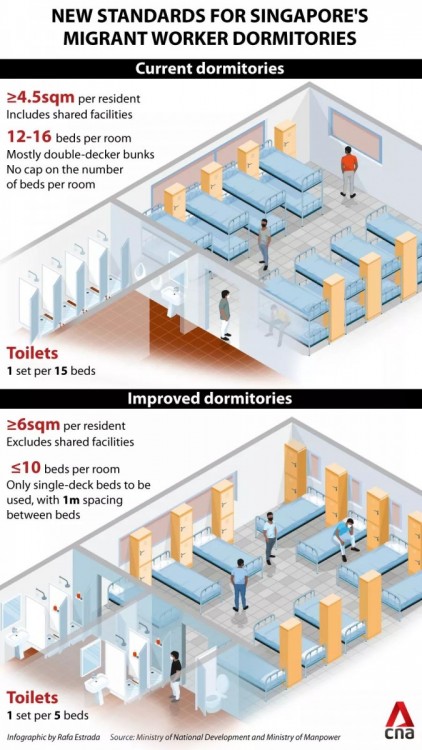Search the Community
Showing results for tags 'dorms'.
-
Source: https://www.straitstimes.com/singapore/1000-dorms-must-meet-12-resident-cap-per-room-other-interim-improved-standards-by-2030-mom SINGAPORE – By 2030, about 1,000 foreign worker dormitories must meet an interim set of housing standards meant to improve their ability to contain disease outbreaks. Some of these interim standards, which include a minimum living space of 3.6 sq m per resident, are less stringent than the higher standards that were announced in 2021. The Ministry of Manpower (MOM) said on Wednesday that by 2040, these 1,000 existing dorms will have to upgrade to the standards unveiled in 2021. Since September 2021, all newly built dorms have had to abide by the higher standards. The 1,000 existing dorms, which have about 235,000 bed spaces, are a mix of dedicated dorms and industrial or warehouse developments that have been partially converted into dorms. MOM said the vast majority of the dorms would move to meet the interim standards progressively between 2027 and 2030 in a transition scheme, with a “small handful” of large dorms doing so earlier as they were assessed to have a higher public health risk. Under the full set of improved standards for worker dorms announced in September 2021, key requirements included a cap of 12 residents per room, a spacing of at least 1m between beds, a minimum of 4.2 sq m of living space per resident and en-suite toilets. As part of the interim standards announced on Wednesday, the minimum required living space per resident is lower, at 3.6 sq m. This is in line with International Labour Organisation standards for worker housing. The 1m bed spacing is also “recommended”, not mandatory. Furthermore, dorms with significant infrastructural constraints will be allowed to have communal toilets instead of en-suite ones, subject to MOM’s approval on a case-by-case basis. Other improvements under the full set of improved standards, such as the provision of Wi-Fi in all rooms, are excluded from the interim standards. MOM said this is because the dormitory transition scheme focuses on critical infrastructural changes that make dorms more resilient against public health risks. It would also be hard for existing buildings to comply with requirements such as the redesigning of sewerage systems to enable wastewater surveillance, as these would entail major and costly renovations, MOM added. The ministry said: “As the risk of large-scale disease outbreaks, such as Covid-19, is rising steadily for several reasons, there is urgency to complete the (transition) as soon as practically possible.” It said the phased approach to the improvements – which comes in the midst of soaring dorm bed rental rates and a tight worker housing market – is to ensure there are enough beds to meet employers’ needs, even as the upgrades happen. During the retrofitting, dorm operators will be expected to put in place plans to minimise disruption to their residents. As part of the transition, dorms will need to apply for a “preferred year” to complete their retrofitting, and these applications are expected to open only from 2025. To spread out the impact on bed supply, there will also be a cap on the number of beds that can be moved to the interim standards yearly, MOM said. MOM is considering providing operators some financial support as part of the transition scheme, and more details will be made public later. Only dorm operators that file applications with MOM will be considered for funding. The ministry said it welcomes the early adoption of standards exceeding the interim ones or the full suite of improvements announced earlier. Dorms with leases expiring in 2033 or earlier will be exempted from the transition scheme, as it would not be practical to require them to undergo retrofitting owing to their short remaining lease durations. But if these dorms wish to secure new leases, they must meet not just the interim standards, but the full set of improvements too. The ministry said the 1,000 dorms under the transition scheme exclude those that already meet the higher standards, and about 200 to 250 temporary quarters. Around 200 dorms are exempted because their leases expire in 2033 or earlier. In designing the transition scheme, MOM said it considered feedback from employers, dorm operators and non-governmental organisations – a process that has taken more than two years. Senior Minister of State for Manpower Koh Poh Koon told reporters on Wednesday that the scheme balances the need for adequate beds with the need to adopt the higher standards as quickly as possible. He said managing the pace of the transition was key, and that infrastructural changes would need time – be they redesigning existing dorm spaces, calling for contracts to carry out the works, or getting the necessary permits and approvals. “I don’t think it is too little, too late, because bear in mind, we have just been coming through the Covid-19 situation,” Dr Koh said. “There will be no perfect solution… It is not as if we can actually decant everybody, rebuild all the dorms and then put everybody back in again.” In March, a government White Paper on Singapore’s response to the Covid-19 pandemic highlighted the handling of the Covid-19 outbreak in worker dorms as a key area in which the Government could have done much better. About half of the 300,000 migrant workers in dorms were estimated to have contracted Covid-19 by the time lockdowns were lifted in August 2020. While the vast majority had mild infections or no symptoms, two died as a result of the disease.
-
https://www.channelnewsasia.com/news/singapore/covid-19-singapore-new-dormitories-foreign-workers-conditions-12792538?cid=FBcna Eight sites have been earmarked for new quick build dormitories by the end of 2020, including in Kranji, Tuas, Admiralty, Choa Chu Kang and Tampines. Under a pilot programme, the living space per resident at the new quick build dormitories will be improved to at least 6 sq m (not including shared facilities) from at least 4.5 sq m per resident (including shared facilities) currently. There will also be a maximum of 10 beds per room. There are currently no limits on the maximum number of beds allowed per room, although in practice, dormitories typically have about 12 to 16 beds in each room. The new set of requirements will see only single-deck beds being used, with 1m spacing between the beds. Double-decker beds are currently mostly used in dormitories. There will also be at least one bathroom, sink and toilet for every five beds, instead of every 15 beds currently.
- 42 replies
-
- 2
-

-
- dormitories
- dorms
-
(and 2 more)
Tagged with:



